Themed collection Collection of articles dedicated to Professor David W. H. Rankin on the occasion of his retirement

Collision induced dissociation (CID ) to probe the outer sphere coordination chemistry of bis-salicylaldoximate complexes
Collision induced dissociation mass spectrometry shows that interactions in the outer sphere of monoanionic Cu(II)salicylaldoximato complexes greatly effects their gas phase stabilities.
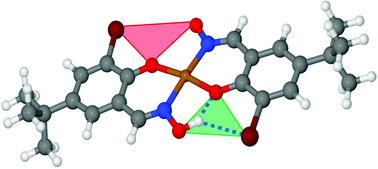
Dalton Trans., 2010,39, 5614-5616
https://doi.org/10.1039/C003135F
Boron –nitrogen analogues of the fluorenyl anion
The synthesis and structural characterisation of [BPh(bipy)] and [BCl(bipy)] are described both of which contain a direduced bipy ligand and are analogues of the fluorenyl anion; DFT calculations highlight differences in the electronic structure of both species compared to the fluorenyl anion.

Dalton Trans., 2010,39, 5084-5086
https://doi.org/10.1039/C0DT00028K
3d –4f Clusters with large spin ground states and SMM behaviour
Molecular 3d–4f cage complexes of {Cu24Ln8}, Ln = Dy, Gd and {Cu16Ln12} are reported. The metal ions in the cages are bridged by Ph3C–PO32−, MeCO2−, OH− and NO3− units. Magnetic measurement of cage {Cu24Dy8} show single molecule magnet (SMM) behaviour while cage {Cu24Gd8} show large spin ground state, ST = 34.

Dalton Trans., 2010,39, 4747-4750
https://doi.org/10.1039/B927114G
Carbodiimide insertion reactions of homoleptic heavier alkaline earth amides and phosphides
1,3-dialkylcarbodiimides insert into the Ae–X (Ae = Ca or Sr, X = NR2, HNAr, PPh2) bonds of a variety of homoleptic heavier alkaline earth species to yield the corresponding guanidinate and phosphaguanidinate complexes.

Dalton Trans., 2010,39, 7393-7400
https://doi.org/10.1039/C0DT00089B
Synthesis and coordination compounds of a bis(imino)acenaphthene (BIAN)-supported N-heterocyclic carbene
The first example of an “Arduengo-type” N-heterocyclic carbene supported by a BIAN ligand has been prepared and structurally authenticated. The preparation and X-ray crystal structures of the AgCl, AuCl, Ir(COD)Cl and Ir(CO)2Cl complexes are also reported.

Dalton Trans., 2010,39, 7401-7408
https://doi.org/10.1039/C0DT00278J
The gas-phase structure of octaphenyloctasilsesquioxane Si8O12Ph8 and the crystal structures of Si8O12(p-tolyl)8 and Si8O12(p-ClCH2C6H4)8
The Si8O12 cages of Si8O12(p-tolyl)8 and Si8O12(p-ClCH2C6H4)8 in the crystalline phase are significantly distorted from the symmetry found for Si8O12Ph8 in the gas phase.

Dalton Trans., 2010,39, 6960-6966
https://doi.org/10.1039/C000664E
Structural studies of some push–pull N-arylbenzazoles
A large interplanar angle between the benzazole and the N-aryl group of the title compounds correlates with a small angle between those of the N-aryl group and the substituent.

Dalton Trans., 2010,39, 7147-7152
https://doi.org/10.1039/C0DT00029A
Theoretical study of the mechanisms of the hydrolysis and condensation reactions of silicon and titanium alkoxides: similarities and differences
In keeping with experimental results, theoretical barrier heights for titanium alkoxides hydrolysis and condensation reactions, are substantially lower than those for silicon alkoxides.
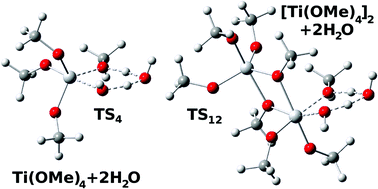
Dalton Trans., 2010,39, 6967-6973
https://doi.org/10.1039/C002397C
The effect of pressure on the crystal structure of [Gd(PhCOO)3(DMF)]n to 3.7 GPa and the transition to a second phase at 5.0 GPa
Pressure induces a phase transition in [Gd(PhCOO)3(DMF)]n in which a stacking contact relieves strain built-up in short H⋯H contacts. The Gd⋯Gd distances increase to facilitate closer packing of the polymer chains.
![Graphical abstract: The effect of pressure on the crystal structure of [Gd(PhCOO)3(DMF)]n to 3.7 GPa and the transition to a second phase at 5.0 GPa](/en/Image/Get?imageInfo.ImageType=GA&imageInfo.ImageIdentifier.ManuscriptID=C0DT00046A&imageInfo.ImageIdentifier.Year=2010)
Dalton Trans., 2010,39, 7004-7011
https://doi.org/10.1039/C0DT00046A
Crystalline di- or trianionic metal (Al , Sm ) β-diketiminates
The unusual X-ray-characterised Al and Sm β-diketiminates containing a reduced trianionic β-diketiminato ligand have been prepared via potassium reduction (Al) or a salt metathesis/disproportionation (Sm) route.

Dalton Trans., 2010,39, 6426-6433
https://doi.org/10.1039/C0DT00071J
Lithium and aluminium carbamato derivatives of the utility amide 2,2,6,6-tetramethylpiperidide
CO2 insertion into a M–N bond (M = Li, Al) gives carbamato derivatives of the utility amide 2,2,6,6-tetramethylpiperidide. Salt metathesis of the Li derivative with the parent aluminium chloride provides an alternative route to the group 13 carbamate. The TMEDA solvated lithium carbamate and the unsolvated aluminium carbamate are both (MOCO)2 dimers in the solid state.

Dalton Trans., 2010,39, 6190-6197
https://doi.org/10.1039/C0DT00118J
Curious matrix effects: a computational, electron diffraction , and vibrational spectroscopic study of dysprosium triiodide
Do molecules keep their shape in low-temperature matrices or not? The possibility of having both planar and pyramidal LnX3 units in noble-gas matrices is indicated by matrix-isolation IR and Raman spectra and computations of DyI3– a molecule that is planar in the gas phase.
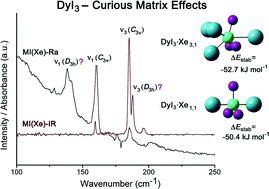
Dalton Trans., 2010,39, 6221-6230
https://doi.org/10.1039/C001182G
Molecular structure of tris(pentafluoroethyl)phosphane P(C2F5)3
The structures of P(C2F5)3 determined in the solid and gaseous state, show it to have a preferred conformation with a sterically shielded binding site; this is expressed by a Tolman angle of ca. 191° (gas) and explains the greater difficulty to act as ligand towards metal atoms as compared to the slimmer P(CF3)3.
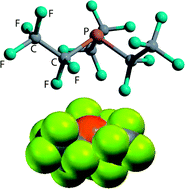
Dalton Trans., 2010,39, 5630-5636
https://doi.org/10.1039/C001310B
The digallane molecule, Ga2H6: experimental update giving an improved structure and estimate of the enthalpy change for the reaction Ga2H6(g) → 2GaH3(g)
Re-analysis of earlier gas-phase electron diffraction (GED) studies of digallane in the light of new quantum chemical calculations affords the most realistic structure available to date. Matrix IR spectra at different temperatures give a first experimental estimate of the dissociation enthalpy of Ga2H6.
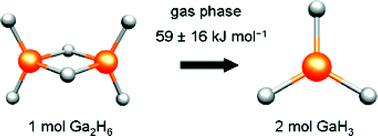
Dalton Trans., 2010,39, 5637-5642
https://doi.org/10.1039/C000694G
The synthesis and reaction chemistry of new amino-functionalised tin(II) alkoxides
The tin(II) aminoalcoholate Sn(ttbap)2 reacts with Fe2(CO)9 in 2 : 1 ratio (Sn : Fe = 1 : 1) to afford the donor–acceptor complex (ttbap)2Sn:→Fe(CO)4 retaining Sn(II), or in 1 : 1 ratio (Sn : Fe = 1 : 2) to give the Sn(0) complex (Httbap)Sn[Fe(CO)4]2, in which Httbap is a neutral zwitterionic form of the ligand.
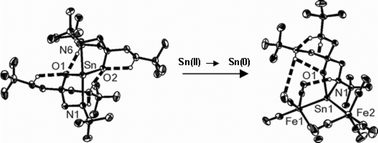
Dalton Trans., 2010,39, 5446-5452
https://doi.org/10.1039/C003178J
Investigating anharmonicity using molecular dynamics calculations: the TM hydride series (PH3)3MH4, (M = Os, Ru and Fe )
We have performed ab initio MD simulations on (PH3)3MH4 (M = Os, Ru and Fe) to quantify the effects of anharmonicity in refining diffraction data sets and interpreting vibrational spectra.

Dalton Trans., 2010,39, 5527-5534
https://doi.org/10.1039/C001161D
Syntheses, X-ray structures and CVD of titanium(IV) arsine complexes
Five titanium arsine compounds have been synthesised from the reaction of TiCl4 with (i) AsPh3, (ii) 2AsPh3, (iii) Ph2AsCH2AsPh2, (iv) tBuAsH2 and (v) As(NMe2)3. Typically 1 : 1 or 1 : 2 adducts were isolated however in the case of As(NMe2)3 an interesting Cl, NMe2 group exchange occurred. The potential for these compounds to deposit TiAs via a single-source CVD route has been investigated.

Dalton Trans., 2010,39, 5325-5331
https://doi.org/10.1039/C001359E
Supraicosahedral indenyl cobaltacarboranes
4,1,6-, 4,1,8-, 4,1,10-, 4,1,12- and 4,1,2- isomers of 13-vertex indenyl cobaltacarboranes have been prepared and subjected to spectroscopic, structural, computational and electrochemical and related studies, with particular attention focused on the orientation of the indenyl ligand.
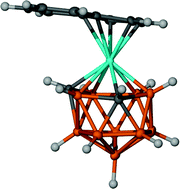
Dalton Trans., 2010,39, 5286-5300
https://doi.org/10.1039/C003067H
Electric field gradients of transition metal complexes from density functional theory: assessment of functionals, geometries and basis sets
An efficient protocol for the first-principles computation of electric field gradients in transition metal complexes is presented.

Dalton Trans., 2010,39, 5319-5324
https://doi.org/10.1039/C001017K
Microwave spectroscopy and structures of two conformers of 1H-heptafluoropropane
The conformers of 1H-heptafluoropropane with HCCC dihedral angles gauche and anti. The anti form appears to have a dihedral angle of 180°, unlike longer fluoroalkane chains which exhibit helical twists.

Dalton Trans., 2010,39, 4575-4578
https://doi.org/10.1039/C000524J
The molecular structure, equilibrium conformation and barrier to internal rotation in decachloroferrocene , Fe(η-C5Cl5)2, determined by gas electron diffraction
While the equilibrium structure of ferrocene is eclipsed, D5h, the equilibrium conformation of decachloroferrocene is staggered, D5d; the barrier to internal rotation in the latter is only 0.8 kJ mol−1, or about one fifth of the barrier in ferrocene.

Dalton Trans., 2010,39, 4631-4635
https://doi.org/10.1039/C001366H
Are cyclopentadienylberyllium , magnesium and calcium hydrides carbon or metal acids in the gas phase?
Athough cyclopentadienylberyllium (CpBeH) is a carbon acid in the gas phase, both CpMgH and CpCaH are metal acids. Both compounds are stronger acids than CpBeH, and only slightly weaker acids than cyclopentadiene.
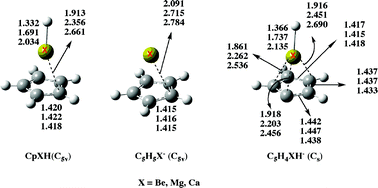
Dalton Trans., 2010,39, 4593-4601
https://doi.org/10.1039/B926653D
The structures of tellurium(IV) halides in the gas phase and as solvated molecules
The structures of molecular tellurium tetrafluoride and tellurium tetrachloride were determined by a combination of gas-phase electron diffraction, mass spectrometry and quantum chemical calculations and compared to the structures of the molecules elucidated by X-ray diffraction of various solvates.

Dalton Trans., 2010,39, 3245-3255
https://doi.org/10.1039/B922474B
Combining the chemistries of silylene and sulfur -nitrogen compounds—SiS2N2 and related systems
A new class of inorganic systems is introduced in which a silylene fragment is combined with a sulfur-nitrogen fragment. These new compounds are stable silylenes in which the sulfur-nitrogen fragment stabilizes both the singlet and the triplet states through electron delocalization.

Dalton Trans., 2010,39, 3256-3263
https://doi.org/10.1039/B923084J
New discrete and polymeric supramolecular architectures derived from dinuclear Co(II) , Ni(II) and Cu(II) complexes of aryl-linked bis-β-diketonato ligands and nitrogen bases: synthetic, structural and high pressure studies
New complexes of the above type are reported.

Dalton Trans., 2010,39, 2804-2815
https://doi.org/10.1039/B920199H
Zwitterionic dicopper helicates: anion encapsulation and binding studies
Spectroscopic studies of a dicopper(II) double helicate capable of encapsulating anions indicate that anion binding strength is dependent on the size and shape of the bound anion.

Dalton Trans., 2010,39, 2936-2941
https://doi.org/10.1039/B922998A
Gas phase structures of chalcogen tetrahalides MX4 with M = S, Se , Te and X = F , Cl , Br , I
Chalcogen tetrahalides: trigonal bipyramidal or tetrahedral structure?

Dalton Trans., 2010,39, 2838-2841
https://doi.org/10.1039/B924628B
Building Fe(III) clusters with derivatised salicylaldoximes
Nine new iron(III) cluster compounds assembled using salicylaldoxime derivatives range in nuclearity from three to twelve and include an unusual F-bridged square.
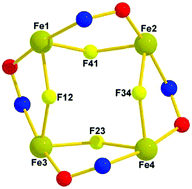
Dalton Trans., 2010,39, 2727-2734
https://doi.org/10.1039/B924143D
Relativistic ab initio study on PtF and HePtF
Highly accurate relativistic ab initio calculations show that the linear HePtF complex has a strong van der Waals He–Pt bond.

Dalton Trans., 2010,39, 2023-2026
https://doi.org/10.1039/B922850K
Low coordinate lanthanide(II) complexes supported by bulky guanidinato and amidinato ligands
A series of homoleptic, four-coordinate guanidinato-lanthanide(II) complexes [Ln(Priso)2] (see picture; Ar = 2,6-diisopropylphenyl, Cy = cyclohexyl) have been prepared and shown to exhibit coordination geometries midway between tetrahedral and planar. This contrasts with their bulkier analogues, [Ln(Giso)2], which have previously been shown to display planar or distorted tetrahedral geometries.
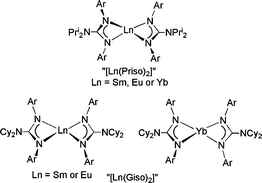
Dalton Trans., 2010,39, 1877-1882
https://doi.org/10.1039/B924367D
Conformational analysis of PEt3 and P(OMe)3 in metal complexes
Conformational preferences for PEt3 and P(OMe)3 ligands in their complexes are identified and analysed. The preferences arise from a combination of intra-ligand effects and the responses of the P-ligands to their environment. The phosphite is the more flexible ligand and pathways between conformers are visible.
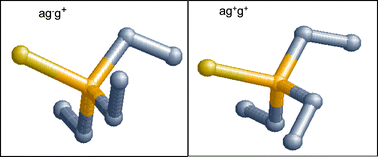
Dalton Trans., 2009, 10436-10445
https://doi.org/10.1039/B916065E
About this collection
Celebrating the retirement of David Rankin
It is with great pleasure that we write this foreword to a collection of articles submitted to Dalton Transactions to mark the formal retirement of David Rankin. As Professor of Structural Chemistry, David’s name has been synonymous with gas electron diffraction research in the UK for more than three decades and is to be found on many an undergraduate reading list thanks to the “Structural Methods in Inorganic Chemistry” book he co-authored with Evelyn Ebsworth and Stephen Cradock. In an academic career spanning more than 40 years David has also published almost 500 papers. He was the most cited electron diffractionist for over nearly 20 years and the most cited chemist in the University of Edinburgh over the same period. He has also given innumerable invited lectures at meetings around the world.
David’s first degree was gained at Cambridge University (where he also developed a love for rowing), followed by research under the supervision first of Evelyn Ebsworth and then George Sheldrick. In 1969 he moved to Edinburgh University as a temporary ICI Research Fellow and never left. He has held many important posts including Head of Inorganic Chemistry and Head of Department. His initial research in the synthesis of germyl compounds paved the way to spectroscopic and structural studies, and an introduction to gas electron diffraction using the Manchester apparatus. After moving to Edinburgh the focus of the synthetic work shifted to fluorophosphine derivatives, but the structural emphasis remained, with the eventual establishment of an Edinburgh gas electron diffraction laboratory. Other sources of structural information also became important, first experimental, including liquid crystal NMR spectroscopy, and, more recently, computational methods.
He received the Royal Society of Chemistry Award for Structural Chemistry (1990), was awarded a Tilden Lectureship (1996), and was elected Fellow of the Royal Society of Edinburgh in 1991. More recently he has been a recipient of the International Dr. Barbara Mez-Starck Prize awarded annually for outstanding contributions in the fields of experimental structural chemistry and molecular physics.
Latterly David has also studied the relationships between metals in plants and soils, accompanied by biennial trips to hunt rhododendrons on Chinese limestone mountains! His love of gardening and plants will keep David occupied in his retirement, taking on a more active role in his family’s plant nursery. Having dominated the Best in Show category at Gardening Scotland for the last few years, David has plans to show off his garden design skills at the Chelsea Flower Show in 2011.
David has a special ability to nurture up-and-coming academic talent and we all owe him a huge debt of gratitude. The dedication and good-humour with which David approaches his work should act as a model to all aspiring chemists. We are delighted to be able to present such an eclectic mix of papers, highlighting not only David’s background in structural chemistry but also as a well-recognised main-group chemist.
Derek A. Wann
Sarah L. Masters
Carole A. Morrison (Guest Editor)